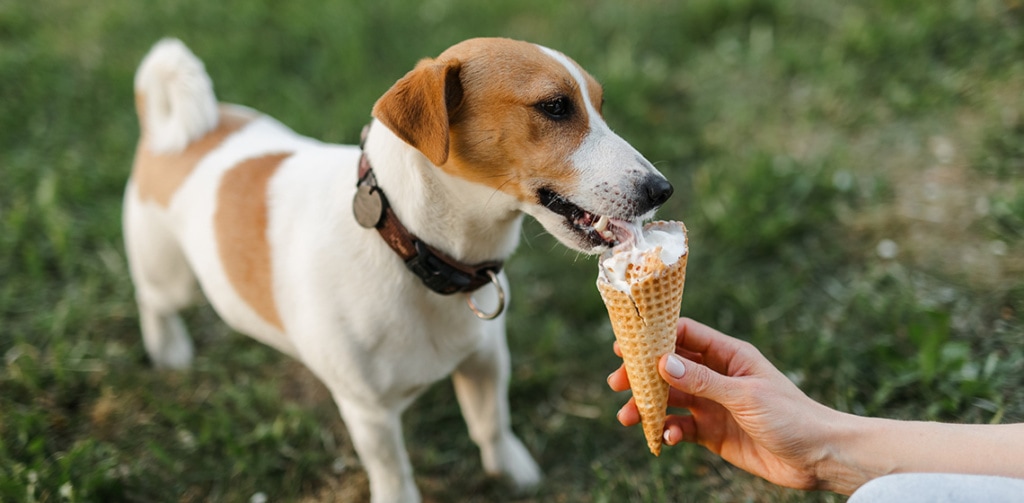Table of Contents
Many people love the seaside, soaking up the sun, splashing in the waves, and enjoying an ice cream. And what could be better than a stroll along the promenade with your pooch? But what if you want to share your frozen treat with your special friend? Can dogs eat ice cream, or could it make them unwell?
Can dogs eat ice cream?
Dogs tend to enjoy ice cream, and a few might be able to eat it without any apparent issues. However, the majority of dogs will develop symptoms of some kind after eating ice cream, and some of these symptoms can be serious. Therefore, it’s safer to avoid giving your dog ice cream altogether and stick to tasty dog-friendly alternatives.
Since most dogs are lactose intolerant and many are sensitive to dairy, they’ll likely develop diarrhea.
Why is ice cream bad for dogs?
There are lots of reasons why ice cream isn’t a sensible snack for your canine companion. Firstly, dogs are lactose intolerant, meaning that they can’t break down the sugar which is commonly found in dairy products. Lactose intolerance can cause your dog to have vomiting or diarrhea, as well as uncomfortable abdominal cramps. Ice cream and other dairy products can also cause diarrhea and skin rashes due to allergies and dietary intolerances.
Pancreatitis and weight gain
On top of this, the high fat content could put your pup at risk of pancreatitis, a severe and painful condition where the pancreas gland becomes inflamed. The high fat content isn’t just responsible for a risk of pancreatitis though, it might cause your pooch to pile on the pounds, and obesity can lead to a shorter life span as well as painful joints.
Toxic ingredients and flavorings
The final risks of feeding your dog ice cream come from the flavors and ingredients themselves. While traditional vanilla ice cream poses no additional risks, sugar-free ice cream may contain the artificial sweetener xylitol, which is toxic to dogs. Chocolate and raisins are also harmful to dogs, so ice cream flavors like chocolate or rum and raisin could make your dog really unwell.
What should you do if your dog eats ice cream accidentally?
If your dog eats ice cream, try not to panic. Most dogs will develop an upset tummy which will settle after a few days of bland food. Examples of bland food you could offer are boiled chicken and rice, plain pasta, scrambled egg, or white fish. However, if your dog has severe vomiting and diarrhea or isn’t eating or drinking, they could become dehydrated. In this situation, an appointment with a veterinary team member will help determine if they need medication or even a fluid drip.
If your dog develops itchy skin or a rash after eating ice cream, and it doesn’t improve within twenty-four hours, they might need to see a veterinarian. One of our veterinarians will be able to prescribe anti-itch or anti-allergy medications to help your furry friend feel more comfortable. Anaphylaxis is very rare, but if your dog develops hives or swelling after eating ice cream, you should phone the veterinary clinic without delay.
If the ice cream that your dog ate might have contained a toxic ingredient, like chocolate, artificial sweeteners, or raisins, your veterinarian may need to make them sick. Therefore, calling us for an emergency appointment straight away is very important.
So, if I can’t feed my dog ice cream, what can I give them instead?
Chocolate and raisins are also harmful to dogs, so ice cream flavors like chocolate or rum and raisin could make your dog really unwell.
There are now some dog-friendly ice cream alternatives available to buy, which are safe for your pooch to eat. If you don’t fancy forking out, though, you could always make your own by freezing mashed banana. Whichever you use, your pup will be able to share the joy of a cooling, icy treat on a warm day!
FAQ
While traditional vanilla ice cream doesn’t contain artificial sweeteners or toxic flavorings, it still contains lactose and high levels of fat. Since most dogs are lactose intolerant and many are sensitive to dairy, they’ll likely develop diarrhea. However, aside from an upset tummy and the obvious risk of gaining weight, there are also risks of more serious conditions like pancreatitis. Therefore, it’s best to avoid giving your dog ice cream altogether.
If your dog eats plain vanilla ice cream, you should monitor them closely for any symptoms. If they develop diarrhea but seem well in themselves, you can try feeding them a bland diet for a couple of days. This could be boiled chicken and rice, pasta, white fish, or scrambled egg. However, if they are off their food or acting unwell, a quick call to the veterinarian will help to decide whether they need an appointment. If they have eaten sugar-free ice cream, chocolate ice cream, or any other toxic ingredient, you will need to take them to see the veterinarian quickly so that they can make them sick.
Some dogs may be able to eat tiny amounts of vanilla ice cream without any problems. If you have tried with a small amount previously and seen no symptoms, it may be safe. It’s essential only to offer small amounts very occasionally, though. And remember, even those without sensitive guts are still at risk from weight gain and pancreatitis. Therefore, it’s much safer to avoid giving your canine companion ice cream at all and give them a safer tasty treat instead.

Dr. Hannah Godfrey MRCVS graduated from the Royal Veterinary College in 2011. Although she initially worked in mixed practice treating all species, she found a love for small animal work and has worked exclusively with dogs and cats since 2014. She lives in Wales with her partner, son, and two cats (named Poppy and Ashton Kutcher), and writes comedy fiction in her spare time.








